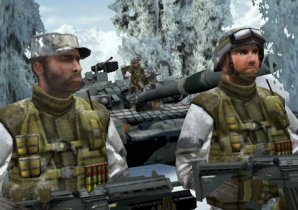 Help us de-mystify what goes on behind the scenes when you team up with a big third party name like EA or Disney. Do third party intellectual property holders typically develop some sort of project plan and then pass development entirely off to you, or do they lend you production resources as well? What advantages and challenges come into play when you work with a third party IP versus your own?
Help us de-mystify what goes on behind the scenes when you team up with a big third party name like EA or Disney. Do third party intellectual property holders typically develop some sort of project plan and then pass development entirely off to you, or do they lend you production resources as well? What advantages and challenges come into play when you work with a third party IP versus your own?
In general, when it comes to developing a game based on a top tier IP there is a need for premium positioning, both in terms of visuals and gameplay, that demands a complex development process and cross-disciplinary expertise (design, graphics, animation, etc.). It means that you need a team with a high technology profile, that can handle from a production point of view a complex development environment with a lot of pressure from the partner company and expectations from the player community, as well as having to contend with a short schedule and controlling all the aspects of the creative process. This is the reason why big publishers have repeatedly turned to us: bringing a top tier IP to a successful high-end mobile game means much more than simply copying the original console title; in general you need to extract the essence of the console gameplay and the feeling of the franchise and re-invent a new game from scratch to accommodate the nuances of the device you’re targeting.
It can vary from one publisher to another but in general they provide a marketing document, and from there we have to invent a game on top of it. They assign a producer who follows the development process very closely and contributes their input.
The principal advantage is to have the opportunity to work on AAA games with big production values and to be able to contribute in building a small piece of an already amazing IP. You also learn a lot from big publishers (processes, business models, tools, etc.). If compared to an in-house development they finance the project whereas in your own game titles you have to finance it completely. On the other hand, the potential return on investment is much higher when you are developing your own IP.
The biggest challenge is without any doubt the high pressure, both in terms of deadline and from Senior Management (and it can go very high), as each of those games are strategic for the Publisher. If you do wrong it can backfire on the image and reputation of the IP’s franchise. The requirements in terms of stability, bug fixing and compatibility are very strict.
 Tell us a little about your proprietary game engine, Karisma. When did development on Karisma begin, and how many games have been built in Karisma to date? In what ways does it give you and your partners a cutting-edge advantage in the crowded and increasingly multi-platform mobile games industry?
Tell us a little about your proprietary game engine, Karisma. When did development on Karisma begin, and how many games have been built in Karisma to date? In what ways does it give you and your partners a cutting-edge advantage in the crowded and increasingly multi-platform mobile games industry?
We started to build what Karisma is today back in 2007. We have built seven games to date using Karisma (plus 4 more games that are still in development). Karisma has two main functions:
It provides a complete game engine to our development teams. Therefore they can benefit from a set of amazing technologies (graphics, multiplayer, etc.) without having to code it again from the ground up, and can instead focus on the game logic itself;
It handles the problem of needing to recode the engine across different smartphone platforms at the same time, thus empowering the team to focus on any particular title’s unique features rather than having to be stuck working in custom implementation of the basics for each OS or hardware platform.
The abstraction layer of Karisma is really stable and very efficient, making it among the quickest engines to integrate into new hardware or operating systems. The iPhone was the first validation of Karisma, as it only took us a couple of days to have Kroll running on iOS and that was at a time when we had never worked on iOS before. After this we have released our games for a range of devices and operating systems as they became available in the marketplace: Samsung H1 for Vodafone on Limo, Apple iPad, Samsung Wave on Bada and more recently we have launched titles on the Sony Ericsson Xperia Play.
When we develop a game for a Publisher it is also done on Karisma and therefore we can in theory deploy the game to any of our supported hardware/OS or on upcoming devices with a minimum of time and effort.
 Karisma brings some exciting things to the table when it comes to the software end of videogame development, but I was also struck by your mention of working with hardware manufacturers like Imagination Technologies, ATI and AMD. What has been the nature of your collaboration with these companies?
Karisma brings some exciting things to the table when it comes to the software end of videogame development, but I was also struck by your mention of working with hardware manufacturers like Imagination Technologies, ATI and AMD. What has been the nature of your collaboration with these companies?
In order to be compatible and to really reach all platforms, we need to support all possible graphics architectures. To that end we try to work with the hardware manufacturers and designers, so that we have early access to their technology to begin integration and expansion of Karisma support. Sometimes hardware manufacturers use our content to help showcase their hardware to mobile manufacturers. In many cases we had already worked with them when we were doing our PC games.
Back to mobile — we did our first OpenGLES2.0 demo three years ago with AMD/ATI (the team was later bought by Qualcomm). We enjoy a special relationship with Imagination Technologies and have been developing demos for them that showcase their technology and products (Extreme Ball last year and Extreme Running this year). This year’s demo runs on 3 different types of devices (mobile, tablet and set-top box) and features a girl whose movements span the devices. In a couple of sequences the girl literally jumps from one device and onto another…a nice and effective way to demonstrate that your content can be running across all platforms and can move from one to another with equal ease.


